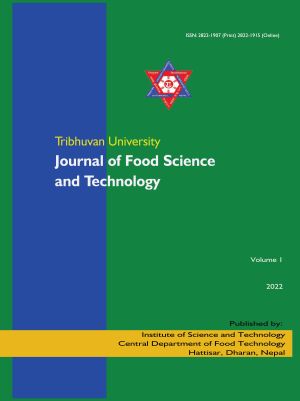Development of Yogurt Analogue by Blending Soy-Maize Milk
DOI:
https://doi.org/10.3126/tujfst.v1i1.49938Keywords:
Plant-based milk, Dairy analogue, Sensory evaluation, Fermentation kineticsAbstract
The aim of this research was to develop yogurt analogue by blending soy-maize milk and to study its sensory and keeping quality. D-optimal mixture design was employed for the formulation of soy-maize yogurt analogue. Five different formulations containing soymilk and maize milk in the ratio of 100:0, 85:15, 70:30, 55:45 and 40:60 were prepared. Sugar (6 g per 100 g milk base), xanthan gum (0.005 g per 100 g milk base) and culture (2U per 20 l) were mixed in all formulations. The prepared yogurts were subjected to sensory evaluation for consumer acceptability. The sensory analysis revealed that soymilk (85%) and maize milk (15%) was of acceptable quality. There was significant difference (p<0.05) between the formulation in terms of color and appearance, flavor, body and texture and overall acceptance. The soy and soy-maize yogurt (optimized) were evaluated for fermentation kinetics (pH, acidity, total plate count and Streptococcus thermophilus count) at the interval of 2 h for 6 h during incubation; and during storage (refrigeration temperature 4-5℃) at the interval of 3 days for 12 days. The physicochemical analysis showed that there was significant difference (p<0.05) in terms of protein, carbohydrate, acidity and syneresis and not significant (p>0.05) in regards of moisture content, fat, ash, and pH between soy and soy-maize yogurt. Also, there was significant difference (p<0.05) in pH, acidity, total plate count and Streptococcus thermophilus count with respect to incubation and storage time for soy and soy-maize yogurt. The yeast and molds count were observed at the 12th day of storage only. The syneresis of soy and soy-maize yogurt was also significantly different (p<0.05) with respect to storage time.
Downloads
Downloads
Published
How to Cite
Issue
Section
License
Copyright (c) 2022 Central Department of Food Technology (CDFT), Tribhuvan University

This work is licensed under a Creative Commons Attribution-NonCommercial 4.0 International License.
This license allows reusers to distribute, remix, adapt, and build upon the material in any medium or format for noncommercial purposes only, and only so long as attribution is given to the creator.




